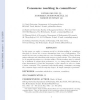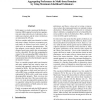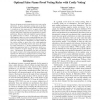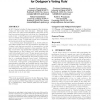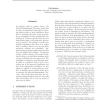WINE
2010
Springer
14 years 10 months ago
2010
Springer
In this paper, we characterize strategy-proof voting rules when the set of alternatives has a multi-issue structure, and the voters' preferences are represented by acyclic CP-...
95
Voted
SIGECOM
2008
ACM
15 years 11 days ago
2008
ACM
The Gibbard-Satterthwaite Theorem states that (in unrestricted settings) any reasonable voting rule is manipulable. Recently, a quantitative version of this theorem was proved by ...
94
Voted
EOR
2007
15 years 12 days ago
2007
In this paper, we apply a consensus model to decision-making in committees that have to choose one or more alternatives from a set of alternatives. The model does not use a voting...
91
Voted
ATAL
2010
Springer
15 years 1 months ago
2010
Springer
In this paper, we study a maximum likelihood estimation (MLE) approach to preference aggregation and voting when the set of alternatives has a multi-issue structure, and the voter...
114
Voted
ATAL
2010
Springer
15 years 1 months ago
2010
Springer
A voting rule is an algorithm for determining the winner in an election, and there are several approaches that have been used to justify the proposed rules. One justification is t...
85
Voted
AAAI
2008
15 years 2 months ago
2008
One way for agents to reach a joint decision is to vote over the alternatives. In open, anonymous settings such as the Internet, an agent can vote more than once without being det...
92
Voted
AAAI
2007
15 years 2 months ago
2007
Sequential composition of voting rules, by making use of structural properties of the voters’ preferences, provide computationally economical ways for making a common decision o...
93
Voted
SIGECOM
2010
ACM
15 years 5 months ago
2010
ACM
In 1876 Charles Lutwidge Dodgson suggested the intriguing voting rule that today bears his name. Although Dodgson’s rule is one of the most well-studied voting rules, it suffers...
79
Voted
TARK
2007
Springer
15 years 6 months ago
2007
Springer
A classical result in voting theory, the Gibbard-Satterthwaite Theorem, states that for any non-dictatorial voting rule for choosing between three or more candidates, there will b...
85
Voted
ATAL
2007
Springer
15 years 6 months ago
2007
Springer
Recent results have established that a variety of voting rules are computationally hard to manipulate in the worst-case; this arguably provides some guarantee of resistance to man...

